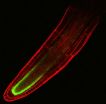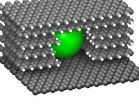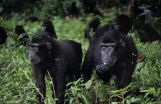(Press-News.org) Washington, D.C. —Until now it has not been clear how salt, a scourge to agriculture, halts the growth of the plant-root system. A team of researchers, led by the Carnegie Institution's José Dinneny and Lina Duan, found that not all types of roots are equally inhibited. They discovered that an inner layer of tissue in the branching roots that anchor the plant is sensitive to salt and activates a stress hormone, which stops root growth. The study, published in the current issue of The Plant Cell, is a boon for understanding the stress response and for developing salt-resistant crops.
Salt accumulates in irrigated soils due to the evaporation of water, which leaves salt behind. The United Nations estimates that salinity affects crops on about 200 million acres (80 million hectares) of arable land and not just in developing countries, but areas such as California as well.
As Dinneny explained: "An important missing piece of the puzzle to understanding how plants cope with stressful environments is knowing when and where stressors act to affect growth."
Roots are intimately associated with their environment and develop highly intricate branched networks that enable them to explore the soil. The branching roots grow horizontally off the main root and are important for water and nutrient uptake.
The scientists grew seedlings of a laboratory plant (Arabidopsis) that is a relative of mustard using a custom imaging system, which enabled them to measure the dynamic process of root growth throughout the salt response. This ability to track root growth in real time led the scientists to observe that branching roots entered a dormant phase of growth as salt was introduced. To determine how dormancy might be regulated, Lina Duan surveyed the role of different plant hormones in this process and found that Abscisic Acid was the key signaling molecule.
"We are familiar with how animals use a fight or flight strategy to face external challenges. While plants can't run for safety, they can control how much they grow into dangerous territory," commented Dinneny. It turns out that Abscisic Acid, a stress hormone produced in the plant when it is exposed to drought or salty environments, is important in controlling the plant equivalent of fight or flight."
To understand how Abscisic Acid controls growth, the investigators devised a strategy to inhibit the response to this hormone in different tissue layers of the root. They developed several mutants in which the response to the hormone was suppressed in different root layers. They found that a significant portion of the salt response was dependent upon how a single cell layer sensed the hormone. The live imaging allowed them to watch what happened to root growth in these mutant plants.
"Interestingly, the 'inner-skin' of the root, called the endodermis, was most critical for this process. This tissue layer is particularly important as it acts like a semipermeable barrier limiting which substances can enter the root system from the soil environment." remarked lead author Duan.
"Our results mean that in addition to acting as a filter for substances in the soil, the endodermis also acts as a guard, with Abscisic Acid, to prevent a plant from growing in dangerous environments," said Dinneny.
"Irrigation of agricultural land is a major contributor to soil salinity. And as sea levels rise with climate change, understanding how plants, particularly crops, react to salt might allow us to develop plant varieties that can grow in the saltier soils that will likely occur in coastal zones."
INFORMATION:
This study was conducted in collaboration with Malcolm Bennett at the University of Nottingham, U.K. Funding of the portion of this work performed at the Temasek Lifesciences Laboratory was provided by the Singapore National Research Foundation. Research performed at the Carnegie Institution for Science was supported by the Carnegie Institution.
The Carnegie Institution for Science (carnegiescience.edu) is a private, nonprofit organization headquartered in Washington, D.C., with six research departments throughout the U.S. Since its founding in 1902, the Carnegie Institution has been a pioneering force in basic scientific research. Carnegie scientists are leaders in plant biology, developmental biology, astronomy, materials science, global ecology, and Earth and planetary science.
Breakthrough: How salt stops plant growth
2013-01-23
ELSE PRESS RELEASES FROM THIS DATE:
Reinventing retirement: New pathways, new arrangements, new meanings
2013-01-23
Retirement involves a set of institutional arrangements combined with socio-cultural meanings to sustain a distinct retirement phase in life course and career pathways. The articles outline that recent forces of change may lead to reinvention of retirement. There are factors that must be recognized as having a significant impact such as the fact that life expectancy and health status of adults over 60 has increased dramatically in recent years. Reinvention could involve change to one or more of the institutional arrangements supporting retirement. New financial risks and ...
Nanoparticles digging the world's smallest tunnels
2013-01-23
This press release is available in German.
The world's smallest tunnels have a width of a few nanometers only. Researchers from Karlsruhe Institute of Technology (KIT) and Rice University, USA, have dug such tunnels into graphite samples. This will allow structuring of the interior of materials through self-organization in the nanometer range and tailoring of nanoporous graphite for applications in medicine and battery technology. Results are now presented in the scientific journal Nature Communications (DOI: 10.1038/ncomms2399).
The tunnels are manufactured applying ...
Researchers create self-healing, stretchable wires using liquid metal
2013-01-23
Researchers from North Carolina State University have developed elastic, self-healing wires in which both the liquid-metal core and the polymer sheath reconnect at the molecular level after being severed.
"Because we're using liquid metal, these wires have excellent conductive properties," says Dr. Michael Dickey, an assistant professor of chemical and biomolecular engineering at NC State and co-author of a paper on the work. "And because the wires are also elastic and self-healing, they have a lot of potential for use in technologies that could be exposed to high-stress ...
Learn to be more understanding by watching The Bachelor (this season, anyway)
2013-01-23
A new USC study finds evidence suggesting that the brain works hard to understand those who have different bodies when watching them in action.
According to the study's lead author, the finding supports initiatives to include more individuals with physical differences in mainstream media – such as Sarah Herron, a contestant on ABC's The Bachelor this season, who was born with a foreshortened left arm.
"Generally, it's considered impolite to stare. But what these results suggest is that we need to look. It's through this visual experience that we're able to make sense ...
New way to identify 'smoked' grapes and wines
2013-01-23
With climate change sparking concern about an increased risk of wildfires, scientists are reporting development of a way to detect grapes exposed to smoke from those fires, which otherwise could be vented into bad-tasting wine. Their report on the method for detecting smoke taint in both grapes and wine appears in ACS' Journal of Agricultural and Food Chemistry.
Yoji Hayasaka and colleagues point out that Australia and other areas of the world are experiencing an increase in bush and wildfires, which may continue and intensify with global climate change. Smoke from those ...
Scientists underestimated potential for Tohoku quake. Now what?
2013-01-23
CORVALLIS, Ore. – The massive Tohoku, Japan, earthquake in 2011 and Sumatra-Andaman superquake in 2004 stunned scientists because neither region was thought to be capable of producing a megathrust earthquake with a magnitude exceeding 8.4.
Now earthquake scientists are going back to the proverbial drawing board and admitting that existing predictive models looking at maximum earthquake size are no longer valid.
In a new analysis published in the journal Seismological Research Letters, a team of scientists led by Oregon State University's Chris Goldfinger describes how ...
Putting the squeeze on cells
2013-01-23
CAMBRIDGE, Mass. — Living cells are surrounded by a membrane that tightly regulates what gets in and out of the cell. This barrier is necessary for cells to control their internal environment, but it makes it more difficult for scientists to deliver large molecules such as nanoparticles for imaging, or proteins that can reprogram them into pluripotent stem cells.
Researchers from MIT have now found a safe and efficient way to get large molecules through the cell membrane, by squeezing the cells through a narrow constriction that opens up tiny, temporary holes in the membrane. ...
Panel recommends changing name of common disorder in women
2013-01-23
An independent panel convened by the National Institutes of Health has concluded that the name of a common hormone disorder in women, polycystic ovary syndrome (PCOS), causes confusion and is a barrier to research progress and effective patient care. The current name focuses on a criterion — ovarian cysts — which is neither necessary nor sufficient to diagnose the syndrome. In a report released today, the panel recommended assigning a new name that more accurately reflects the disorder.
"The name PCOS is a distraction that impedes progress. It is time to assign a name ...
Better outlook for dwindling black macaque population in Indonesia
2013-01-23
Since at least the 1970s, the population of critically endangered Sulawesi black macaques living in an Indonesian nature reserve has been dropping. But a new study by researchers at the University of Washington and in Indonesia shows that the population has stabilized over the past decade.
The findings, published in the January issue of the American Journal of Primatology, are from the longest ongoing survey of Macaca nigra and are among the first evidence that the monkeys may be in better shape.
"Fifteen years ago it looked like this macaque population would continue ...
Treatment targeting PI3K may delay resistance to anti-HER2 therapy in breast cancer patients
2013-01-23
PHILADELPHIA — Patients with HER2-positive breast cancer being treated with anti-HER2 therapy may be able to prevent or delay resistance to the therapy with the addition of a phosphatidylinositol-3 kinase inhibitor to their treatment regimens.
The data, published in Cancer Research, a journal of the American Association for Cancer Research, indicated that failure of the anti-HER2 antibody trastuzumab to block HER2 from activating the phosphatidylinositol-3 kinase (PI3K) signaling pathway can lead to resistance to treatment. Therefore, dual simultaneous inhibition of ...



